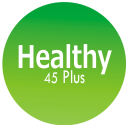Stroke is often a medical emergency in which the blood supply to the brain is affected. It can severely affect people in the middle ages and above. It is believed to be one of the leading causes of death in the elderly.
However, it is also important to know that stroke, if detected in time can help you get timely treatment. Also, stroke can be prevented or you can reduce your risk of stroke and its complications. It is important to know about stroke, its symptoms, warning signs, treatment, and the action that you must take to prevent complications.
For a healthy 45 plus, preventing stroke and seeking timely treatment is crucial
Know about stroke
Stroke is a condition in which the arteries carrying blood to the brain are affected. The blood vessels carrying nutrients and oxygen to the brain are very important. Stroke can occur when these arteries are either blocked or ruptured, resulting in reduced or interrupted blood supply to the brain. This means there is a lack of adequate oxygen and nutrients, which can damage the brain tissue, resulting in the death of brain cells. But if timely action is taken and the person receives immediate medical aid, you can reduce brain damage and other complications.
As stroke is a medical emergency, knowing the signs is crucial. If you are aware of the signs that could indicate the possibility of stroke, you can seek immediate medical attention.
Types of stroke
All types of strokes ultimately affect the blood supply to the brain. But the treatment modality, recovery, and further instructions may vary depending on the type of stroke. Here are the three common types of stroke.
• Ischaemic stroke – This type of stroke occurs due to blockage of the artery supplying oxygen-rich blood to the brain. This is the commonest type affecting most people. Blood clots in the arteries commonly cause an ischaemic stroke.
• Haemorrhagic stroke – This type of stroke occurs when the artery to the brain bursts or gets ruptured and begins to leak. This leads to bleeding or haemorrhage in the brain, which exerts too much pressure on the brain cells, damaging them.
• Transient Ischaemic attack – This type is also known as a mini-stroke, is a temporary clot, and is considered as a precursor of a major stroke episode. In this, the blood flow to the brain is blocked for a short span, usually not more than five minutes. As it is one of the main warning signs of a stroke, this too is a medical emergency.
In some cases, the cause of a stroke cannot be determined, in which cases it is called a cryptogenic stroke. Sometimes, stroke can affect both sides of the body, resulting in a locked state, when the person is unable to move below the neck or speak. This is called a brainstem stroke.
Risk factors of stroke
High blood pressure, in which the pressure of blood in the arteries is high, is a leading cause of stroke. Conditions like previous stroke episodes, transient ischaemic attacks, high cholesterol, heart diseases, diabetes, and sickle cell disease raise the risk of stroke.
Some of the risk factors of stroke can include a faulty diet – high in trans-fat and unhealthy fats, a sedentary lifestyle causing physical inactivity, consuming excess alcohol and smoking, or being obese. Family history can be important as genetic factors like high blood pressure, high blood cholesterol, history of stroke can raise the risk.
The risk of stroke increases with age. So taking the right steps in the middle ages can ensure healthy aging.
Know the symptoms of stroke
It is very important to know the symptoms of a stroke. If you or the person around you begins experiencing such symptoms, it is necessary to note the time the symptoms begin. Some of the common symptoms of stroke include the following
• Trouble speaking, slurred speech, and difficulty in understanding what others are saying
• Difficulty in seeing, blurred vision, double vision may occur in one or both eyes
• Sudden weakness, numbness, often affecting one side of the body. Difficulty in raising one arm or drooping of one side of the mouth
• Sudden, severe headache, sometimes with dizziness, vomiting, or unconsciousness
• There may be trouble walking, stumbling, or loss of balance and coordination difficulty
Some of the other symptoms of stroke may include pain in the face, legs, hiccups, shortness of breath, chest pain, fast heartbeats, feeling weak all over.
Warning signs of stroke
A simple test to know the warning signs can be done using the acronym F.A.S.T. that makes it easy to remember. A person in stroke needs immediate medical attention, So think FAST – in the real sense too.
The warning signs of stroke include
F – Face: Check the smile – Does the face droop on one side? Is the smile uneven?
A – Arms: Check for weakness on one side of the body – Does one arm drift downward?
S – Speech: Check the speech – Is it slurred or strange?
T – Time: Check the time – Did the symptoms appear suddenly? Call medical help immediately?
Treatment mainly depends on the cause and type of stroke.
Preventing stroke
Here are some of the important ways to prevent a second stroke. You can plan a healthy lifestyle with these easy tips from experts.
• Monitor your blood pressure regularly
• Keep your cholesterol in check
• Control your blood sugar level
• Stay active – do some physical exercises daily
• Eat better – choose healthy foods over unhealthy fats
• Lose weight is you are obese and maintain an ideal weight
• Stop smoking and limit alcohol intake
See your doctor and get your health conditions treated in time. Heart conditions and previous stroke-like symptoms need appropriate treatment. Plan a healthy lifestyle and follow the given medical advice.
References
1. https://www.cdc.gov/stroke/index.htm
2. https://www.stroke.org/en/about-stroke/types-of-stroke
3. https://www.stroke.org/-/media/stroke-files/life-after-stroke/secondary-prevention/8-ways-to-help-prevent-a-second-stroke-ucm_500738.pdf?la=en
- All You Need To Know About Brain Stroke - October 1, 2020
- The Aging Knee – What Can You Do? - August 27, 2020
- What Is Osteoarthritis? How To Prevent or Manage It? - August 24, 2020


 Please wait...
Please wait...